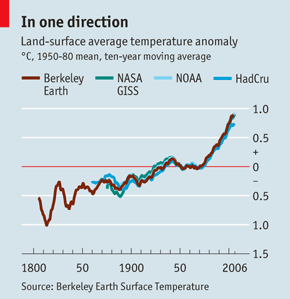A recent article in The Economist discusses findings released October 20th by the Berkeley Earth Surface Temperature group, which includes this month's Nobel prize-winning physicist Saul Perlmutter and is led by astrophysicist Richard Muller. The group started a new climate change measurement project 18 months ago in order to "address the concerns of what Dr Muller terms 'legitimate skeptics'" of climate change who have qualms with inconsistencies in available temperature data that may exaggerate temperature changes. One way the group attempted to minimize possible exaggerating effects of inconsistencies was by developing an algorithm that weights data points in such a way that "awkward" data and "outlandish readings" are still included in the data but also don't distort the ultimate trends (as opposed to simply omitting so-called awkward data). The group also developed a "more nuanced heat map" that utilizes "basic spatial correlations in weather to estimate the temperature at points between weather stations." However, even after these innovations and addressing other possible biasing factors, the group found climate change trends similar to those published by other climate research institutions, including NASA, suggesting that existing temperature data is more or less accurate. Whether or not this will actually mitigate climate change skepticism is yet to be determined, as the newly published findings are currently being peer reviewed. The graph from the article (below) compares the land-surface average temperature anomaly measures found by the Berkeley Earth Surface Temperature Group, NASA, NOAA and Hadley CRU. As the graph shows, all sources exhibit the same general upward trend between 1800 and 2006. Furthermore, most climate research institutions, including Berkeley Earth, estimate about a 0.9 degree Celsius increase in land temperatures over the past 50 years.
BL cf
BL cf






0 komentar:
Post a Comment